Types of Minerals, Definition, Classification, Examples, Uses, FAQs
Before going to the types of minerals first of all we need to discuss minerals. Minerals are inorganic solid compounds found in nature that are formed by geological processes. Different types of minerals are found in the earth's crust some of them are unnamed as well. And among the minerals found only 30 of them are most common and important. It is found in most of the earth's parts and so it is very important in our daily life.
NEET 2025: Mock Test Series | Syllabus | High Scoring Topics | PYQs
JEE Main: Study Materials | High Scoring Topics | Preparation Guide
JEE Main: Syllabus | Sample Papers | Mock Tests | PYQs
- Classification of minerals
- Examples of minerals
- Different types of minerals
- Minerals and their uses
- Difference between metallic and nonmetallic minerals
- Minerals list
Minerals can also be called natural chemicals as they are found in nature. We use many methods of mining to extract important materials from minerals for example metal, coal, oil, sands, etc. Some minerals are found in excess in the earth's crust and some are least abundant minerals, silica is found mostly in the earth's crust.
Classification of minerals
They are being naturally found so they are classified according to their chemical composition and crystalline structure. So the classification of minerals are:
- Native elements: silver, graphite, diamond, silver, etc. are native elements.
- Oxides: corundum, hematite, spinel, etc. are oxide minerals.
- Sulfides: Pyrite, Galena, sphalerite, etc.
- Sulfates: Baryte, gypsum
- Hydroxides: Goethite, brucite
- Carbonates: Calcite, magnesite, dolomite
- Halides: Fluorite, halite
- Phosphates: Apatite, monozite
- Framework silicates: Quartz, zeolites, feldspars
- Sheet silicates: Muscovite mica, clay minerals.
- Ortho silicates: Garnet, olivine
Also read -
- NCERT Solutions for Class 11 Chemistry
- NCERT Solutions for Class 12 Chemistry
- NCERT Solutions for All Subjects
Examples of minerals
A mineral is a solid substance that is present in a crystalline form where the atoms fit together in it. For a given type of crystal, the chemical composition is the same for all the crystals of that type. Some of the examples of minerals are calcite, diamond, gold, graphite, etc. Many of these minerals have resemblance to one another like quartz looks like a diamond and green colored plastic looks like an emerald. But their chemical compositions are entirely different even though they are identical in their physical appearances.
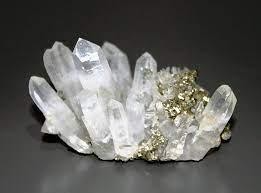 Mineral Quartz
Mineral Quartz
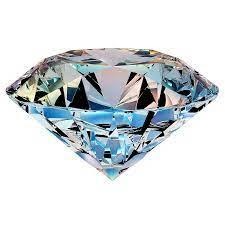 Mineral Dimond
Mineral Dimond
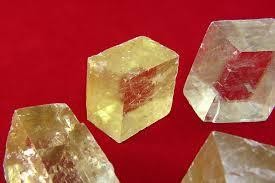 Calcite Mineral
Calcite Mineral
Different types of minerals
Based on the crystalline form, the chemical composition and structure of minerals are classified into two. It is mainly classified into two types that are metallic and nonmetallic minerals. Of which the metallic minerals are classified into ferrous and nonferrous minerals.
Metallic minerals definition
The minerals that consist of metals in their chemical composition are metallic and they possess a metallic luster in their physical appearance. It is the main source of metal and metals can be extracted from these minerals by the process of mining. Based on the chemical composition of metallic minerals they are found in earth crust as oxides, sulfides, carbonates, halides, etc. Of the metallic minerals, gold is the only one that is found in the pure form.
Some of the examples of metallic minerals are bauxite, magnetite, iron ore, bauxite, etc. are some of the metallic minerals. Bauxite ores are normally found in deeply weathered rocks and also volcanic rocks contain bauxite deposits in certain regions. The very important mineral is iron ore and iron metal is extracted from the ore of iron and through the extraction and the elimination of impurities iron can be easily extracted from iron ore. The ore which has a silvery appearance and is brittle in nature are manganese ore they are found in many forms and are found extensively in nature.
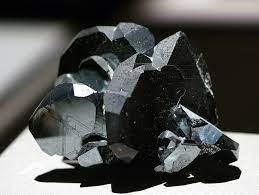 Hematite or iron ore
Hematite or iron ore
Metallic minerals are classified into ferrous minerals and nonferrous minerals. Since iron is the most commonly found on the earth's crust. So those elements that contain iron in their chemical compositions are ferrous minerals and that one does not contain iron in their chemical composition or nonferrous minerals.
Related Topics Link, |
Non-metallic minerals
Those minerals which do not contain metals in their chemical composition are non-metallic and they possess a nonmetallic luster or shine in their physical appearance. So it cannot be used for the extraction of metals as it does not contain metals and their chemical composition. Gypsum, limestone, mica, etc. are examples of nonmetallic minerals.
Of the types of minerals, metallic minerals have much application. After all, it does not contain metals to extract but it is still useful for human needs. Silica is the most extensively found nonmetallic mineral and is used in the construction field. Coal is used to produce electric power in thermal power plants. And diamond is a mineral that can be used for jewelry.
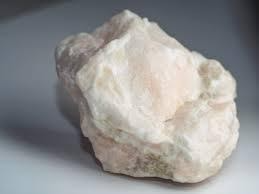 Gypsum Mineral
Gypsum Mineral
Identification of minerals
By using a simple hand specimen minerals can be easily identified and since there are only two types of minerals. They have distinctive physical properties like specific gravity, streak, so can be easily distinguished from their appearance. The pieces of information obtained are not so detailed one so a detailed examination is needed to get a better understanding of minerals.
So by examining with the help of a microscope thin section will enable detailed information since their optical properties are unique and different. The use of XRD, microprobe analysis, mass spectrometry, etc., and many other analytical identification methods can be undertaken to get an accurate result.
Also, students can refer to,
- NCERT Solutions for Class 12 Chemistry Chapter 6 General Principles and Processes of isolation of
elements - NCERT Exemplar Class 12 Chemistry solutions Chapter 6 General Principles and Processes of isolation of
elements - NCERT notes Class 12 Chemistry Chapter 6 General Principles and Processes of isolation of elements
Minerals and their uses
- Hematite
One of the very important ores that can be used to extract iron is hematite. It is also known as iron oxide, Fe2O3 since it is easily found in its oxide form. Iron is a very important metal for our daily life activities.
- Gold
Gold is the only mineral that is found in its pure form or elemental form. Gold is used as jewelry. And it has some other applications in chemical reactions.
- Coal
It is a mineral that consists of carbon and is the most commonly used fossil fuel. It is now extensively used to produce electricity in thermal power stations and also used as a domestic fuel.
- Diamond
It is also an allotrope of carbon that contains carbon mainly. It is used as jewelry since it is a very lustrous material. And also it is used as a cutter for industrial applications.
Difference between metallic and nonmetallic minerals
| Metallic | Nonmetallic |
| Metallic minerals contain metals in their chemical composition. | Nonmetallic minerals do not contain metals in the chemical composition of minerals. |
| They have a shiny appearance. | They do not have a shiny appearance. |
| These are most commonly found in igneous rocks. | Nonmetallic minerals are generally found in sedimentary rocks. |
| They are malleable. | They are not malleable. |
| Ores of iron, aluminum, silver, gold, etc. are examples of metallic minerals. | Diamond, mica, etc. are examples of non-metallic minerals. |
Minerals list
Some of the minerals are given below.
- Fluorite
- Gypsum
- Sodalite
- Magnetite
- Quartz
- Mica
- Pyrite
- Calcite
- Labradorite
- Hematite
- Bauxite
- Carnallite
- Diamond
Also check-
- NCERT Exemplar Class 11th Chemistry Solutions
- NCERT Exemplar Class 12th Chemistry Solutions
- NCERT Exemplar Solutions for All Subjects
NCERT Chemistry Notes:
Frequently Asked Questions (FAQs)
Minerals are naturally found chemicals that contain useful components. It is an inorganic solid compound found in nature whereby the process of extraction and mining of important compounds can be obtained.
There are mainly two types of minerals they are; metallic and nonmetallic minerals. This metallic is again classified into ferrous and nonferrous minerals.
Ore is the mineral deposit.
Hematite and magnetite
Minerals are homogeneous.
Also Read
06 Feb'25 11:59 PM
06 Feb'25 11:54 PM
09 Dec'24 11:00 AM
21 Oct'24 04:24 PM
07 Oct'24 02:35 PM
07 Oct'24 02:24 PM
07 Oct'24 02:17 PM
07 Oct'24 12:55 PM
04 Oct'24 07:17 PM

